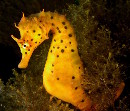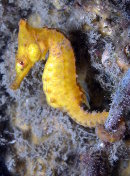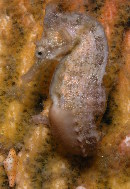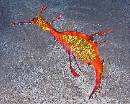
Seahorses are a bony teleost fish and similar to fishes they posses gills, fins and a swim bladder. They belong to the family Syngnathidae and the word Syngnathidae is derived from the Greek words ‘syn' (meaning together or fused) and ‘gnathus' (meaning jaws). This family includes seahorses, pipefishes, pipehorses and seadragons. Syngnathids have close relatives occurring in the same order (Syngnathiformes or Gasterosteiformes) and these include Aulostomidae (trumpetfishes), Centriscidae (razorfishes), Fistulariidae (flutemouths or cornetfishes), Indostomidae (paradox fishes), Macrorhamphosidae (bellows fishes), Pegasidae (sea moths) and Solenostomidae (ghost pipefishes) (Lourie et al 1999, Kuiter, 2000).
 Seahorses all belong to the one genus, Hippocampus , which is derived from the Greek words ‘hippos' (meaning horse) and ‘campus' (meaning sea monster) (Lourie et al 1999). There are some differences between tropical and temperate species and it is possible that further studies may warrant sub genera being created (Kuiter, 2000).
Seahorses all belong to the one genus, Hippocampus , which is derived from the Greek words ‘hippos' (meaning horse) and ‘campus' (meaning sea monster) (Lourie et al 1999). There are some differences between tropical and temperate species and it is possible that further studies may warrant sub genera being created (Kuiter, 2000).
Seahorses have a broad distribution throughout the world however they are not found in cold temperate seas. The Indo-Pacific region has the greatest diversity of species with Australia having more than ten species of seahorse in its waters (Lourie et al 1999), whilst many south-east Asian countries (such as Philippines and Indonesia ) and Japan have at least seven species in their waters (Lourie et al 1999). The diversity of seahorses in the eastern Pacific, Caribbean and the eastern and western Atlantic is greatly reduced with only several species found in these areas (Lourie et al 1999). There are no seahorses known to have a broad geographical range with most species being confined to a small number of countries or regions (Kuiter, 2000).
 Most species are found in shallow coastal habitats (less than 20 metres) but some species are known to occur in water depths of up to 150 metres (Lourie et al 1999). Seahorses are predominantly found in marine environments however some species can tolerate lower salinities and occur in areas with freshwater influences such as Hippocampus capensis from South Africa (the ‘Knysna' seahorse) that experiences fluctuating salinity levels in its estuarine environments (Bell et al. 2003, Whitfield, 1995). Some have specialized habitat ( Hippocampus bargibanti on gorgonians) whilst other species such as Hippocampus abdominalis and Hippocampus whitei are found in a variety of habitats. In addition, seahorses inhabit shallow, coastal areas worldwide, where anthropogenic disturbances tend to be most frequent and severe. (Bell et al, 2003)
Most species are found in shallow coastal habitats (less than 20 metres) but some species are known to occur in water depths of up to 150 metres (Lourie et al 1999). Seahorses are predominantly found in marine environments however some species can tolerate lower salinities and occur in areas with freshwater influences such as Hippocampus capensis from South Africa (the ‘Knysna' seahorse) that experiences fluctuating salinity levels in its estuarine environments (Bell et al. 2003, Whitfield, 1995). Some have specialized habitat ( Hippocampus bargibanti on gorgonians) whilst other species such as Hippocampus abdominalis and Hippocampus whitei are found in a variety of habitats. In addition, seahorses inhabit shallow, coastal areas worldwide, where anthropogenic disturbances tend to be most frequent and severe. (Bell et al, 2003)
 There is international concern about declining seahorse populations worldwide as a result of over harvesting, declining water quality and damage to their habitats. There is serious concerns over the status of many seahorse and pipefish populations as a result of their capture in trawl fishing operations where they are taken as bycatch. In areas such as Vietnam, Indonesia and the the Philippines populations of seahorses have noticable declined. More than 25 million dead and live seahorses are traded globally on an annual basis with around 95% of these being used in traditional medicines; aquarium and souvenir trade make up the rest. In the 1990s, some seahorse populations were observed to shrink between 25 to 50 percent over five years.
There is international concern about declining seahorse populations worldwide as a result of over harvesting, declining water quality and damage to their habitats. There is serious concerns over the status of many seahorse and pipefish populations as a result of their capture in trawl fishing operations where they are taken as bycatch. In areas such as Vietnam, Indonesia and the the Philippines populations of seahorses have noticable declined. More than 25 million dead and live seahorses are traded globally on an annual basis with around 95% of these being used in traditional medicines; aquarium and souvenir trade make up the rest. In the 1990s, some seahorse populations were observed to shrink between 25 to 50 percent over five years.
 Like most animals, seahorses, seadragons,
pipefish, ghostpipefish and pipehorses are found in areas inhabited by their
favoured prey. Often the ends of jetties are rich with syngnathiformes due to
water circulation patterns that deliver rich patches of zooplankton and shrimp
on which they feed. Seahorses in particular are able to wrap their tails around
structures and feed on passing prey organisms. Pipefish are present among many
reed-like seagrasses where their body shape and colour mimics their surroundings.
Here they are able to employ their sit and wait feeding strategy to attack unsuspecting
small crustacean prey.
Like most animals, seahorses, seadragons,
pipefish, ghostpipefish and pipehorses are found in areas inhabited by their
favoured prey. Often the ends of jetties are rich with syngnathiformes due to
water circulation patterns that deliver rich patches of zooplankton and shrimp
on which they feed. Seahorses in particular are able to wrap their tails around
structures and feed on passing prey organisms. Pipefish are present among many
reed-like seagrasses where their body shape and colour mimics their surroundings.
Here they are able to employ their sit and wait feeding strategy to attack unsuspecting
small crustacean prey.
 There
are at least 31 syngnathids
(7 seahorses) and four solenostomids (ghostpipefish) species known to exist in NSW
waters. Two of these species, the white's seahorse Hippocampus whitei and the
pygmy pipehorse Idiotropiseis lumnitzeri, are considered to be endemic to NSW. Only two species are known to occur in Port Stephens (Hippocampus abdominalis and Hippocampus whitei).
There
are at least 31 syngnathids
(7 seahorses) and four solenostomids (ghostpipefish) species known to exist in NSW
waters. Two of these species, the white's seahorse Hippocampus whitei and the
pygmy pipehorse Idiotropiseis lumnitzeri, are considered to be endemic to NSW. Only two species are known to occur in Port Stephens (Hippocampus abdominalis and Hippocampus whitei).
On the 1 July 2004 all species of the families sygnathidae and solenostomidae became listed as "protected" under the NSW Fisheries Management Act 1994. It is an offence to collect or harvest any seahorse, seadragon, pipefish, pipehorse or ghostpipefish species in NSW waters without a permit or licence, and heavy penalties apply. For corporations, these penalties can include fines of up to $55,000 while in other cases they can include fines of up to $11,000 and up to 3 months in prison.
 Limited
quantities of syngnathiformes may be collected for scientific purposes, as aquaculture
broodstock or for other specific uses, however this will only be allowed under
permit and only once the impacts of any proposed collecting is assessed to ensure
the viability of local populations. The new protection afforded by the NSW Fisheries
Management Act 1994 will allow for monitoring controls over trade and the collection
of these species by aquarists.
Limited
quantities of syngnathiformes may be collected for scientific purposes, as aquaculture
broodstock or for other specific uses, however this will only be allowed under
permit and only once the impacts of any proposed collecting is assessed to ensure
the viability of local populations. The new protection afforded by the NSW Fisheries
Management Act 1994 will allow for monitoring controls over trade and the collection
of these species by aquarists.
A new PhD research project has commenced through the University of Newcastle with support from Project Seahorse and the NSW Department of Primary Industries. This research will focus on the syngnathids within the Port Stephens – Great Lakes Marine Park and will examine the distribution and abundance of Hippocampus whitei within the Fly Point - Halifax Park Aquatic reserve and similar habitats outside the reserve. Surveys will also examine the habitat preference and depth range for Hippocampus whitei and also monitor the distribution and abundance of other syngnathid species within Port Stephens (such as the Tiger Pipefish Filicampus tigris ). This project is expected to be completed by 2010 and for further information contact the author.
Bell , E.M., J.F. Lockyear, J.M. McPherson, D. Marsden & A.J. Vincent. 2003. First field studies of an Endangered South African seahorse, Hippocampus capensis . Environmental Biology of Fishes 67: 35–46.
Kuiter, Rudie H ., 2001. Revision of the Australian seahorses of the genus Hippocampus (Syngnathiformes: Syngnathidae) with descriptions of nine new species. Records of the Australian Museum 53(3): 293–340.
Kuiter, R.H. 2000. Seahorses, Pipefishes and their relatives: a Comprehensive Guide to Syngnathiformes. TMC Publishing, Chorleywood , UK . 240 pp.
Lourie , S.A. , A.C.J. Vincent & H.J. Hall. 1999.Seahorses: An Identification Guide to the World's Species and their Conservation. Project Seahorse, London , U.K. 214 pp.